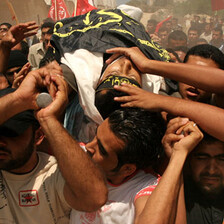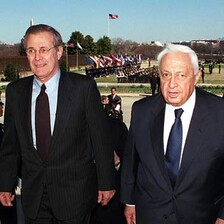The Electronic Intifada 19 April 2005
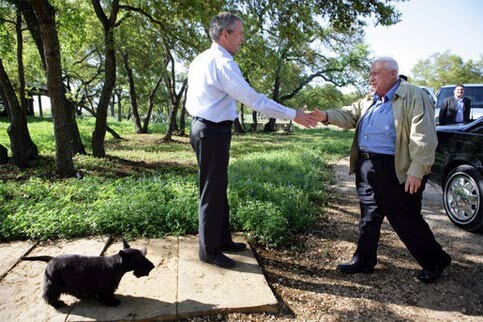
Israeli Prime Minister Ariel Sharon is greeted by President George W. Bush upon the Prime Minister’s arrival Monday, April 11, 2005, to the President’s ranch in Crawford, Texas. (Photo: White House/Eric Draper)
Ariel Sharon travelled to the United States as a hero of peace, as if he had already evacuated Gaza and only the follow-up remained to be worked out. What has completely disappeared from the public agenda is what is happening, meanwhile, in the West Bank. The media continue to deluge us daily with disengagement storms, like the Nitzanim bubble. But for now the disengagement exists only on paper. On the ground, no settler has yet received compensation. Even those who agreed to accept compensation are now waiting, because if they have a chance to get Nitzanim settlement on Gaza’s beach — the pearl of Israeli real estate — why hurry?
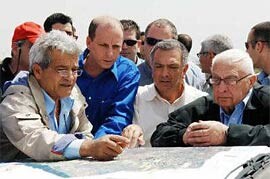
Israeli Prime Minister Ariel Sharon tours Nitzanim dunes area in Gaza, one of the areas touted as a possible site of new homes for the evacuated settlers from the Gaza Strip. (Photo: Ohayon Avi/GPO HO)
On 8 April 2005, Ofer Petersburg reported in Yediot Ahronot that “The Settlement Department of the Jewish Agency, responsible for providing the ‘caravillas’ [the caravans that were supposed to host the evacuated settlers temporarily] has so far received no order from the government.”
If Sharon intends to evacuate the Gaza settlements, he is doing so with outrageous inefficiency. He is far more efficient in the West Bank. There, plans are carried out precisely as scheduled. Right from the start, during the first agreements between Sharon and Netanyahu one year ago about the disengagement plan, it was agreed that the disengagement would not be put into effect before the separation fence was completed on the western side of the West Bank.[1]
Indeed, the construction of the wall is moving towards completion. In July, which is the announced date for the beginning of the Gaza evacuation, the wall surrounding East Jerusalem and cutting it off from the West Bank, will be in place. The Palestinians who live there will be able to leave only with permits. The centre of life in the West Bank will become an enclosed prison. As well, the northern wall, which has already imprisoned the residents of Tulkarem, Qalqilya and Mas’ha, and which has robbed them of their land, continues to advance southwards. Now the bulldozers are headed for the land of Bil’in and Safa, bordering the settlements of Modi’in Elit. The farmers who are losing their land are trying to stand their ground, together with Israeli opponents of the wall. But who will hear about their sufferings and their struggle amidst the tumult over the disengagement?
The disengagement plan was born in February 2004, at the height of a wave of international criticism over the wall and on the eve of the opening of deliberations at the International Court of Justice in The Hague. In the ruling that was handed down in July, the Court determined that the route of the wall was a blatant and serious violation of international law. Moreover, the court indicated that there was a danger of “a further change in the demographic composition as a result of the departure of the Palestinian population from certain areas” (at para 122). In other words, the court warned of a process of transfer.
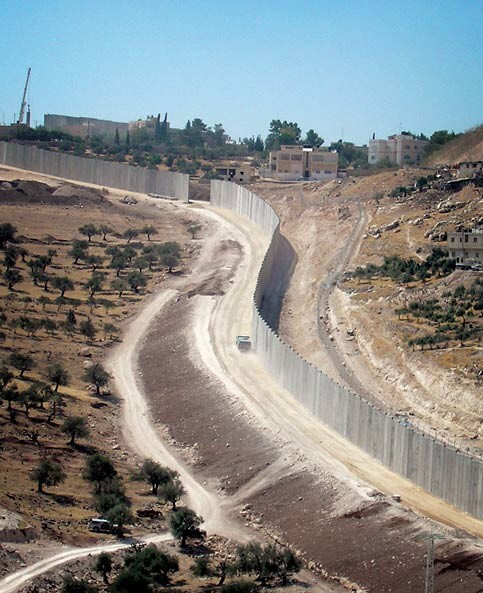
The Wall snaking across the West Bank. (Photo: Arjan El Fassed)
According to United Nations data, 237,000 Palestinians will be trapped between the wall and the Green Line and 160,000 others will remain on the Palestinian side, cut off from their land. The route that was approved at the government’s meeting in February 2005 reduces their number only slightly.[2]
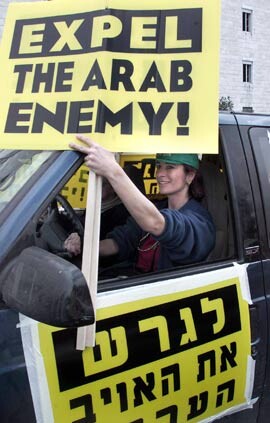
Nadia Matar, head of the extreme right-wing group Women in Green, drives a car pasted with Hebrew and English slogans to “Expel the Arab Enemy” during a four-car convoy protest through Jerusalem, 17 March 2002. (Photo: AFP/Menahem Kahana)
“Transfer” is associated in the collective memory with trucks arriving at night to take Palestinians across the border, as occurred in some places in 1948. But behind the smoke screen of disengagement, a process of slow and hidden transfer is being carried out in the West Bank today. It is not easy to judge which method of “transferring” people from their land is more cruel. Nearly 400,000 people, about half the number of Palestinians who were forced to leave their land in 1948, are now candidates for “voluntary emigration” to refugee camps in the West Bank. And all this is currently being passed over in silence because maybe Sharon will disengage.
Prof. Tanya Reinhart is a lecturer in linguistics, media and cultural studies at the Tel Aviv University. She is the author of several books, including Israel/Palestine: How to End the War of 1948, from which this article was excerpted from an updated chapter. This article first appered in Yediot Aharonot on 13 April 2005 and was translated from Hebrew by Mark Marshall.
Footnotes
1. For example, some reports from April last year:
2. These figures are from the ICJ advisory opinion of July 9. Similar figures were provided in the Israeli media — for example, Meron Rappaport, Yediot Aharonot, 23 May 2003; Akiva Eldar, Ha’aretz, 16 February 2004. The new line of the barrier as approved by the Israeli cabinet on 20 February 2005 reduces the size of Palestinian land to be annexed by the barrier by 2.5%, mainly in the Southern Hebron area, where work is only starting (so the barrier route can still change many times as the work progresses). There were smaller adjustments in other areas, dictated by decisions of the Israeli Supreme Court, which means that some of the encircled villages should get some of their land back. But this does not effect the total number of Palestinians encircled by the wall. In Khirbet Jbara in the Tulkarm Governorate, the cabinet approved moving a 6km section of the barrier closer to the Green Line. As a result, the Palestinian population in this area will no longer be located in a completely closed area, but rather on the West Bank side of the barrier. This will reduce the overall Palestinian population completely isolated from the West Bank by about 340 persons, according to UN OCHA report of March 2005 on the preliminary analysis of the effects of the new wall route approved in February 2005 (www.ochaopt.org).
Related Links

